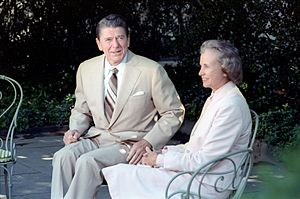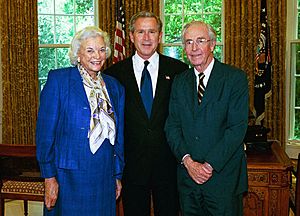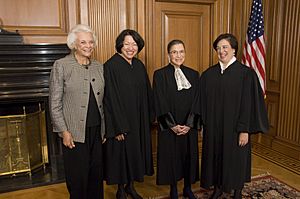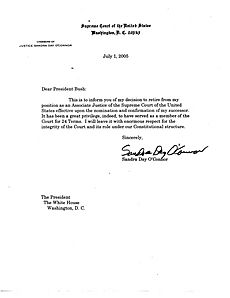Sandra Day O'Connor facts for kids
Quick facts for kids
Sandra Day O'Connor
|
|
|---|---|

Official portrait, c. 2002
|
|
| Associate Justice of the Supreme Court of the United States | |
| In office September 25, 1981 – January 31, 2006 |
|
| Nominated by | Ronald Reagan |
| Preceded by | Potter Stewart |
| Succeeded by | Samuel Alito |
| Judge of the Arizona Court of Appeals for Division One |
|
| In office December 14, 1979 – September 25, 1981 |
|
| Nominated by | Bruce Babbitt |
| Preceded by | Mary Schroeder |
| Succeeded by | Sarah D. Grant |
| Judge of the Maricopa County Superior Court for Division 31 | |
| In office January 9, 1975 – December 14, 1979 |
|
| Preceded by | David Perry |
| Succeeded by | Cecil Patterson |
| Member of the Arizona Senate | |
| In office January 8, 1973 – January 13, 1975 |
|
| Preceded by | Howard S. Baldwin |
| Succeeded by | John Pritzlaff |
| Constituency | 24th district |
| In office January 11, 1971 – January 8, 1973 |
|
| Preceded by | Constituency established |
| Succeeded by | Bess Stinson |
| Constituency | 20th district |
| In office October 30, 1969 – January 11, 1971 |
|
| Preceded by | Isabel Burgess |
| Succeeded by | Constituency abolished |
| Constituency | 8-E district |
| 23rd Chancellor of the College of William & Mary | |
| In office October 1, 2005 – February 3, 2012 |
|
| President | Gene Nichol Taylor Reveley |
| Preceded by | Henry Kissinger |
| Succeeded by | Robert Gates |
| Personal details | |
| Born |
Sandra Day
March 26, 1930 El Paso, Texas, U.S. |
| Died | December 1, 2023 (aged 93) Phoenix, Arizona, U.S. |
| Political party | Republican |
| Spouse | |
| Children | 3 |
| Relatives | Ann Day (sister) |
| Education | Stanford University (BA, LLB) |
| Awards | Presidential Medal of Freedom (2009) |
| Signature | |
Sandra Day O'Connor (born March 26, 1930 – died December 1, 2023) was an American lawyer and politician. She made history as the first woman to serve as an associate justice of the Supreme Court of the United States. She held this important role from 1981 to 2006. She was the first woman ever nominated and confirmed to the highest court in the U.S.
Contents
- Early Life and Family
- Education and Law School
- Early Career in Law and Politics
- Serving on the Supreme Court
- Retirement from the Court
- Life After the Supreme Court
- Helping Others and Non-Profits
- Personal Life
- Interesting facts about Sandra Day O'Connor
- Sandra Day O'Connor quotes
- Legacy and awards
- Images for kids
- See also
Early Life and Family
Sandra Day was born in El Paso, Texas. Her father, Harry Alfred Day, was a rancher. Her mother was Ada Mae (Wilkey). Sandra grew up on a very large cattle ranch in Arizona. The ranch was about 198,000 acres. It was far from towns, about nine miles from the nearest paved road.
Her family home did not have running water or electricity until Sandra was seven years old. She had two younger siblings, a sister named Ann Day and a brother named H. Alan Day. Ann Day later became a politician in Arizona. Sandra and her brother wrote a book together called Lazy B: Growing up on a Cattle Ranch in the American West. It was about their childhood on the ranch.
Education and Law School
For most of her early school years, Sandra lived in El Paso with her grandmother. She went to a private school called Radford School for Girls. The family ranch was too far from schools. She would return to the ranch for holidays and summer breaks.
For eighth grade, she lived at the ranch and rode a bus 32 miles to school. She finished high school at Austin High School in El Paso in 1946. She was one of the top students in her class.
When she was 16, Sandra went to Stanford University. She earned her first degree, a B.A. in economics, in 1950. She then went to Stanford Law School and got her law degree in 1952. While there, she worked on the Stanford Law Review. The main editor was William Rehnquist, who later became the Chief Justice of the Supreme Court. Sandra was in the top 10 percent of her law school class.
Early Career in Law and Politics
After finishing law school, O'Connor found it hard to get a paid job as a lawyer because she was a woman. She offered to work for free as a deputy county attorney in San Mateo, California. She even shared an office with a secretary. After a few months, she started getting a small salary. She did legal research and wrote important documents.
She also volunteered in political groups. She helped with the presidential campaign for Arizona Senator Barry Goldwater in 1964.
From 1965 to 1969, O'Connor worked as an assistant Attorney General of Arizona. In 1969, the governor of Arizona chose her to fill an open spot in the Arizona Senate. She won the election for that seat the next year. By 1973, she became the first woman to be a Majority Leader in any state's senate. She was known for being a good negotiator and a moderate thinker. After serving two full terms, O'Connor decided to leave the Senate.
In 1974, O'Connor was appointed a judge for the Maricopa County Superior Court. She served there from 1975 to 1979. Then, she was promoted to the Arizona State Court of Appeals. She worked on the Court of Appeals until 1981. That's when President Ronald Reagan appointed her to the Supreme Court.
Serving on the Supreme Court
When President Reagan nominated O'Connor for the Supreme Court, the Senate approved her unanimously. This meant everyone agreed she was a good choice.

O'Connor felt a big responsibility to show that women could do the job of a justice. She even faced small problems, like there being no women's restroom near the courtroom.
A few years after she joined the Court, The New York Times wrote an article that talked about the "nine men" of the "SCOTUS" (Supreme Court of the United States). O'Connor wrote a letter back, reminding them that the Court no longer had only nine men. She even called herself FWOTSC, which stood for "First Woman On The Supreme Court."
O'Connor believed it was important for the justices to work well together. She often made sure they ate lunch together.
In 1993, Ruth Bader Ginsburg became the second female Supreme Court justice. O'Connor said she felt relieved because she was no longer the only woman on the Court, and the media stopped focusing on that so much.
On July 1, 2005, O'Connor announced she would retire. She said she would leave once a new justice was confirmed. Samuel Alito was chosen to take her place in October 2005. He joined the Court on January 31, 2006.
During her time on the Court, some magazines called O'Connor one of the most powerful women in the world. After leaving the Court, she became the Chancellor of the College of William & Mary. This was a special, mostly ceremonial role.
Retirement from the Court

By 2005, the Supreme Court had the same justices for eleven years. This was one of the longest times without any changes in American history.
On July 1, 2005, O'Connor said she planned to retire. In her letter to President Bush, she said her retirement would happen when her replacement was confirmed. She didn't give a reason in the letter. However, a Supreme Court spokesperson said O'Connor was leaving to spend more time with her husband.
On October 31, President Bush nominated Judge Samuel Alito to replace O'Connor. Alito was confirmed by a vote of 58 to 42. He was sworn in on January 31, 2006. Even after retiring, O'Connor continued to hear cases. She worked as a substitute judge in federal courts across the country.
Life After the Supreme Court

As a retired Supreme Court Justice, O'Connor still received her full salary. She also had an office with at least one law clerk. She continued to hear cases part-time in federal district courts and courts of appeals.
She was involved in a project called the Sandra Day O'Connor Project on the State of the Judiciary. This group held yearly meetings from 2006 to 2008. They talked about how independent the court system should be.
From 2006, she was a trustee on the board of the Rockefeller Foundation. This is a group that gives money to good causes.
On October 4, 2005, College of William & Mary announced that O'Connor would be their 23rd Chancellor. This was a mostly honorary role. O'Connor stayed in this position until 2012.
O'Connor was also part of the 2006 Iraq Study Group. This group was put together by the U.S. Congress to study the war in Iraq.
She helped lead the Jamestown 2007 celebration. This event marked 400 years since the first English colony was founded in Jamestown, Virginia.
O'Connor was a member of the American Philosophical Society and the American Academy of Arts and Sciences. These are groups that honor important thinkers and scholars.

Teaching and Writing
Starting in 2006, O'Connor taught a two-week course called "The Supreme Court." She taught it every spring at the University of Arizona's law school. In 2007, she also taught a course at the Sandra Day O'Connor College of Law at Arizona State University.
She wrote a book in 2013 called Out of Order: Stories from the History of the Supreme Court.
Helping Others and Non-Profits
In February 2009, O'Connor started a website called Our Courts. She created it to give students and teachers fun, interactive lessons about how the government works. She was worried that many young Americans didn't know enough about their government.
The website grew and became iCivics in May 2010. It offers free lesson plans, games, and interactive video games for middle and high school students. By 2015, 72,000 teachers were using iCivics. Its games had been played 30 million times.
She also served on the board of the National Constitution Center in Philadelphia. This is a museum about the U.S. Constitution.
In 2009, O'Connor started a non-profit group now called the Sandra Day O'Connor Institute. This group works to promote good discussions, community involvement, and civics education. In 2019, her former home in Arizona was added to the National Register of Historic Places. The O'Connor Institute now manages it.
She was also a member and president of the Junior League of Phoenix.
Personal Life
Sandra Day dated William Rehnquist in 1950. He asked her to marry him, but she said no.
In her last year of law school, she started dating John Jay O'Connor III. They got married on December 20, 1952, at her family's ranch.
When her husband was drafted into the Army, O'Connor went with him to Germany. She worked there as a civilian lawyer for the Army. They stayed for three years. Then they moved back to Arizona to start their family. They had three sons: Scott (born 1958), Brian (born 1960), and Jay (born 1962). After Brian was born, O'Connor took five years off from working as a lawyer.
When she was appointed to the Supreme Court, O'Connor and her husband moved to Washington, D.C.. They became active in the social life there. O'Connor enjoyed playing tennis and golf. She was a member of the Episcopal Church.
O'Connor was treated for breast cancer in 1988. Her husband, John O'Connor, suffered from Alzheimer's disease for almost 20 years. He passed away in 2009. She became involved in raising awareness about Alzheimer's disease. After retiring from the Court, O'Connor moved back to Phoenix, Arizona.
Around 2013, her friends noticed she was becoming more forgetful. By 2017, she needed a wheelchair because of back problems and moved to an assisted living facility. In October 2018, O'Connor announced she was retiring from public life. She shared that she had been diagnosed with early stages of Alzheimer's-like dementia.
Interesting facts about Sandra Day O'Connor
- As a child, she owned a .22-caliber rifle. She would use it to shoot coyotes and jackrabbits.
- She started driving as soon as she could see over the dashboard. She had to learn to change flat tires by herself.
- O'Connor was made an honorary member of Phi Beta Kappa by the College of William and Mary in 2008.
- On August 12, 2009, President Barack Obama gave her the Presidential Medal of Freedom. This is a very high honor.
- In 2003, she wrote a book called The Majesty of the Law: Reflections of a Supreme Court Justice.
- In 2005, she wrote a children's book, Chico. It was named after her favorite horse and told stories about her childhood.
- After John Paul Stevens died in 2019, O'Connor became the last living Justice who had served on the Burger Court.
Sandra Day O'Connor quotes
- "Do the best you can in every task, no matter how unimportant it may seem at the time."
- "We don't accomplish anything in this world alone... and whatever happens is the result of the whole tapestry of one's life and all the weavings of individual threads form one to another that creates something."
- "I don't know that there are any short cuts to doing a good job."
Legacy and awards
Images for kids
-
O'Connor is sworn in by Chief Justice Warren Burger as her husband John O'Connor looks on.
-
Justice O'Connor presents Alberto Gonzales to the audience after swearing him in as U.S. Attorney General, as Becky Gonzales looks on.
See also
 In Spanish: Sandra Day O%27Connor para niños
In Spanish: Sandra Day O%27Connor para niños




